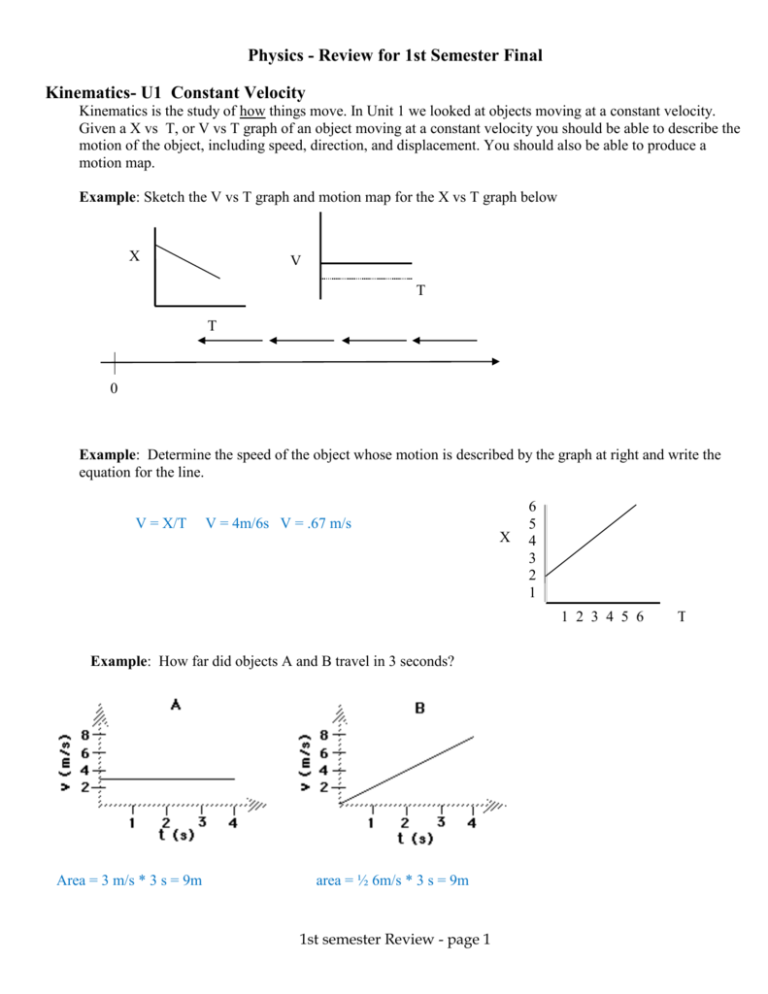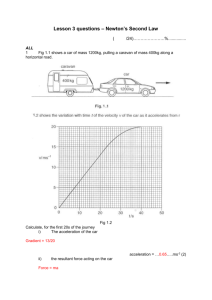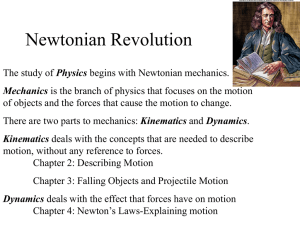Phys. 1st Sem Rev 95-96
advertisement

Physics - Review for 1st Semester Final Kinematics- U1 Constant Velocity Kinematics is the study of how things move. In Unit 1 we looked at objects moving at a constant velocity. Given a X vs T, or V vs T graph of an object moving at a constant velocity you should be able to describe the motion of the object, including speed, direction, and displacement. You should also be able to produce a motion map. Example: Sketch the V vs T graph and motion map for the X vs T graph below X V T T 0 Example: Determine the speed of the object whose motion is described by the graph at right and write the equation for the line. V = X/T V = 4m/6s V = .67 m/s X 6 5 4 3 2 1 1 2 3 4 5 6 Example: How far did objects A and B travel in 3 seconds? Area = 3 m/s * 3 s = 9m area = ½ 6m/s * 3 s = 9m 1st semester Review - page 1 T Kinematics- U2 Constant Acceleration In Unit 2 we examined objects experiencing a change in velocity (acceleration). Given a X vs T, or V vs T , or A vs T graph of an object moving with a changing velocity you should be able to describe the motion of the object, including speed, direction, and displacement. You should also be able to produce a motion map.Also use the following equations to solve problems: v at v0 , x 12 at 2 v0t , v 2f v20 2ax Example: How does the displacement, instantaneous velocity, and acceleration of object A compare to object B at 3 s? A B Displacement A=B same ∆X ( vert axis) X Inst Vel A>B greater slope Acc A>B B has NO acc T Sketch a motion map for both A and B A B 0 Example: Determine the acceleration of the object whose motion is depicted at left. Write the equation for the line. V A = ∆V/T 6 5 4 3 2 1 A = -5 m/s / 4s = -1.25 m/s2 1 2 3 4 5 6 T Example: Draw the corresponding graphs based upon the information provided in the given graph. x x x t t V V V a a a t t t 1st semester Review - page 2 t t t Examples: A cart travels along a straight section of road. A velocity vs time graph illustrating its motion is graphed to the right. (a) Indicate every time t for which the cart is at rest. A, C, F, but only for instant (b) Indicate every time interval for which the speed (magnitude of velocity) of the cart is increasing. A-B, C-D neg, F-G (c) What is the acceleration from a – b? 5m/s / 3 s = 1.7 m/s2 (d) What is the acceleration from b – c? Same as part C, but neg 1.7 m/s2 (e) What is the acceleration from d – e? Zero. Constant vel. Of -5m/s2 v (m/s) b 5 g c a f 5 15 10 5 d t (s) e velocity time graph (f) What is the acceleration from e – g? 9m/s / 3 s = 3 m/s2 2-D Motion In Unit 3, 2D motion, we examined the motion of projectiles. A projectile follows a parabolic path. The horizontal motion of the projectile is constant velocity, the vertical motion is acceleration. Use the kinematic equations from Units 1&2 to solve projectile problems. Example: You are on top of a building that is 55.0 m tall. You toss a ball straight up. It travels 35.0 m up before it stops and begins to fall back down. (a) What was the ball’s initial velocity? It goes up and then falls down to the ground below. (b) How much time is it in the air? a) Vf2 = 2A∆X+ Vi2, at the top of the flight the V is zero so Vi = 26.5 m/s 0 = 2(-10 m/s2)(35 m) + Vi2, b) Several methods, Vi = Vf, so use Vf = AT + Vi, -26.5 m/s = (-10 m/s2)T + 26.5 m/s , T= 5.3s for top half, then use Yf = 1/2 AT2 + VyT + Y0 to find time for 55m, T=1.3s .Total time = 6.9s Example A 5 kg bowling ball rolls off the roof of a 50 m building at 12 m/s. a. How long does it take the ball to reach the ground? ∆Y = 1/2 AT2 + VyT, Vy =0, so 50m = ½(-10 m/s2)T2, T = 3.16 s b. How far from the building does it hit? ∆X = VT + X0, ∆X = 12 m/s (3.16s) + 0, ∆X = 37.9 m 2. Repeat problem 1 above with the ball leaving at a 30˚ angle. Vx = 10.45 m/s Time 3.82 s, ∆X = 39.5m Vy = 6.0 m/s 1st semester Review - page 3 Statics In Unit 4 we moved from how things moved to why things move. Objects in Unit 4 are moving at a constant speed, with no net force. You should be able to state and give examples of Newton's 1st and 3rd laws. You should also be able to draw a force diagram for an object in static equilibrium and solve any of the forces acting on the object. Examples: Draw a force diagram that correctly depicts the forces acting on a given object. 1. A stapler sits motionless on a desk. 2. A ball rolls across the floor at constant speed. 3. A box sits motionless on an angled ramp. 4. The boy pushes the mower at constant speed. If the boy is pushing the mower (m=75kg) with a 200 N force at an angle of 37˚, calculate the frictional force necessary to keep the mower moving at a constant velocity. ∑ F = 0, Fs + Fb/x = 0, Fs + 200n cos(37) = 0, Fs = 160 N Examples: solve static problems Write the equation which describes the forces which act in the x-direction. ∑ Fx = 0, T2 + T1x = 0, T2 + T1sin(25) = 0 Write the equation which describes the forces which act in the y-direction. ∑ Fy = 0 W + T1cos (25) = 0, T1 = 50N/cos25, T1 = 55.2 N Determine the magnitude of T1 and T2. T2 + 55.2 N sin(25) = 0, T2 = 23.3 N Examples: State and give an example, using force diagrams, of Newton's 3rd law. A horse exerts a 500 N force on a heavy wagon, causing it to accelerate. What force does the wagon exert on the horse? The Forces are the same 500N 1st semester Review - page 4 Part 2 Dynamics In unit 5 we had objects accelerating due to a net force. You should be able to state and give examples of Newton's 2nd law. You should also be able to draw a force diagram for an object experiencing a net force and solve for any of the forces acting on the object or the acceleration. Examples a. Sketch the graphs that show the relationship between acceleration and force and between acceleration and mass. A A F M b. If the same force is applied to two objects, one 10 kg and the other 20 kg, how do their accelerations compare? A α 1/m , so if mass is doubled then A would be 1/2 c. Compare the acceleration a hockey puck experiences when first 5 N, then 10 N of force is applied. A α F, so if F is doubled then A would double also Draw a force diagram to represent the situation, then write equations for objects experiencing multiple forces, and solve for acceleration or force. Examples 1. What is the acceleration of an 800 kg elevator when the cable applies 10 000N force upward? ∑ Fx = ma, Fc + Fe = ma, 10,000 N -8000 N = 800 kg A, A = 2.5 m/s2 2. What is the tension in the cable if the elevator accelerates downward at 3.0 m/s2? ∑ Fx = ma, Fc + Fe = ma, Fc -8000 N = 800 kg -3.0 m/s2 , Fc = 5600 N 3. What would be the apparent weight of a 70 kg boy in the elevator in (2)? ∑ Fx = ma, Fn + Fe = ma, Fn -700 N = 70 kg -3.0 m/s2, Fn = 490 N 4. A 5.0 kg box sits at the top of a frictionless ramp. a. What is the Fg in the x-direction? Fgx = 50sin(15) = 12.9 N b. What is the acceleration of the box down the ramp? ∑ Fx = ma, Fex = ma, 12.9 N = 5.0 kg A, A= 2.6 m/s2 c. How fast would the block be moving after sliding 2.0m? Vf2 = 2A∆X+ Vi2, Vf = 10.4 m/s 1st semester Review - page 5 5. A 5.0 kg box is pulled along a frictionless surface by a 40N force acting at a 30° angle from the horizontal. a. What is the acceleration of the box? ∑ Fx = ma, Ftx = ma, 40 Ncos(30) = 5.0 kg A, A = 6.9 m/s2 b. What is the normal force acting on the box? ∑ F = 0, Fn + Fty + Fe = 0, Fn + 40 Nsin(30) – 50N = 0, Fn = 30 N Energy & Work Energy is a conserved, substance- like quantity that is involved whenever there is a change in the state of a system. If an object moves higher or lower in the Earth’s gravitational field, or its speed changes or a spring is compressed or the object is dragged across a rough surface, then energy is involved. Energy is measured in Joules (J) which is a Nm. Energy can be stored in the following ways: Gravitational potential Energy –stored in the Earth’s gravitational field Eg= mgh Kinetic Energy – stored in the motion of an object, depends on Velocity E k= Elastic Energy- stored in springs, bungee cords, any stretchy things E el= mv2 kx2 Internal Energy- energy ‘lost’ due to friction, heat, noise, etc. Remains in the system, hence the Internal part! Eint= Fk∆x The energy of a system is constant unless an outside agent interacts with it. When an external agent applies a force and energy either enters or leaves the system, this is called Work. W= FII ∆x, where the Force is parallel to the displacement of the object. You should be able to calculate the energy stored in the system AND the changes in the system energy when something changes (position, speed, etc). Examples:1. An object is launched with some velocity, V, and reaches a height of 10m. If the velocity were doubled how high would the object rise? H=40m 2. If an object traveling 10 m/s can stop in 5.0m, what is the stopping distance if the object were traveling 20 m/s? ∆x = 20m 1st semester Review - page 6 3. An object has twice as much Ek as another with the same mass. How much faster is the first object? V= or 1.4 times greater 4. You raise a 25kg bale of hay by pulling a rope, connected to a pulley system, at a constant speed. You pull the rope a distance of 16 m. The bale travels 8.0 m higher than before. What force did you apply? F =125 N 5. You apply a force if 10N on a 4.0kg object resting on a frictionless surface for 5.0m. How fast is it traveling at this point? V=5m/s 6. You are helping a friend move, ugh! You have to get a 50kg sofa up 1.0 m into the bed of a truck. Which requires less energy, lifting the sofa up on to the truck or using a dolly and rolling up a 30˚ ramp? Same work, same height Eg=mgh 7. Use the Conservation of Energy principle to relate the energy of an object at different positions. Using the diagram of the rollercoaster below: a. At what point on the ride would a car have the lowest E g, lowest Ek? the lowest Eg=b,d , lowest Ek=a b. At what point would the roller coaster riders be traveling the fastest? B or d, assuming no friction c. If a spring were placed at pt E, how much energy would be stored in the spring when the car comes to a stop? 1/5 of the total would be Eel, the rest would be Eg Power-is the rate at which energy if transferred P= 8. In problem Q6 what is your power output if you lift the sofa onto the truck in 3.0s. What if the dolly takes 6.0s? P= 167w, P= 83w 1st semester Review - page 7 Uniform Circular Motion (We didn’t get through all of this. There may be one question like below) Example: 1. Convert the following angles from degrees to radians. a. 10˚ b. 45˚ a. .174 rad b. .785 2. Convert the following angles from radians to degrees. a. π/25 rad b. π/10 rad a. 7.2˚ b. 18˚ Momentum We did a brief examination of momentum which is the product of mass and velocity. Momentum is a conserved quantity, the total momentum in a system remains constant. You should be able to solve problems with both elastic and inelastic collisions. We also looked at change in momentum and the impulse necessary to cause a change. You should be able to solve impulse problems. Example: 1. A bumper car with Stunt Man Nyall as the driver (total mass = 80 kg), moving at 10.0 m/s, collides with a stationary bumper car with Nyall’s brother Brent as the driver (total mass = 70 kg). After the collision, Nyall’s car has a velocity of – 2.0 m/s. a. Draw diagrams representing the bumper cars before and after the collision. B4 After Nyall Brent Nyall Brent b. What is the velocity of Brent’s car after the collision? mv + mv = mv + mv 80 kg(10 m/s) + 0 = 80 kg(-2.0 m/s) + 70 kg v V = 13.7 m/s c. What is the change in momentum of Nyall’s car? ∆ρ = m∆v, ∆ρ = 80 kg (-2.0 – 10m/s), ∆ρ = 960 kgm/s d. If the cars are in contact for 0.200s, what is the magnitude of the force each car exerts on the other? F∆T = m∆v, F(0.200s) = 960 kgm/s, F= 4800 Ns 1st semester Review - page 8









